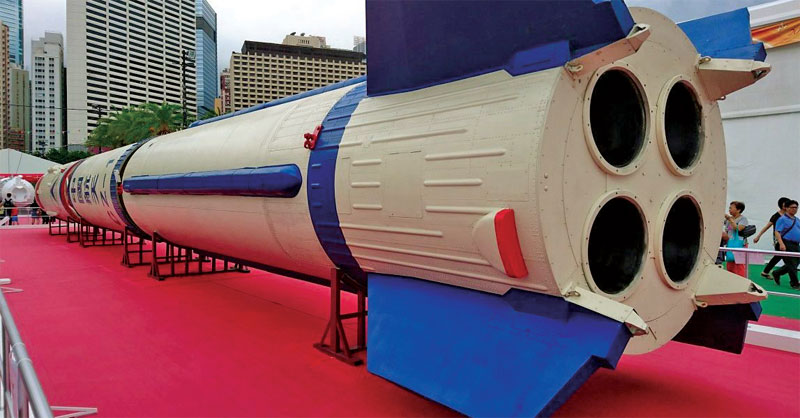The Indian military needs to make a sustained investment in space-based technologies
 Air Cmde K.A. Muthana (retd)
Air Cmde K.A. Muthana (retd)
For me, and I know for my leadership in the administration, there are no more important areas to prioritize than missile warning…
Frank Kendall, Secretary of the Air Force, DoD, USA
This is a sequel to the two of my earlier articles that appeared in the October 2021 and February 2022 editions of FORCE. The former contained measures needed to fix capability gaps in the future fixed wing fleet of Indian Air Force. The latter covered the need for an AI enabled quantum secure combat cloud that would make flexible theaterisation possible. The present article delves into a domain that is crucial for air defence: Space.
Capability in Space
It is with huge relief that one notices progressive liberation of space activity in India. For decades it was in the bear-grip of government-controlled agencies which shunned interaction with the military under the pretext of threat of sanctions by Western suppliers. There was little realisation that it was due to sanctions that a couple of great innovations took place, as in the LCA programme.
As a result of such throttling, we are at the tail end of the race in the second space age where exploitation of space for national security. Now that enthusiastic players from the private sector are being allowed in, there is hope for faster progress in the field. Space debris situation is only going to get worse. Countries and companies are scrambling to launch before regulation is brought in.
Space assets are being used to support operations across the spectrum of combat like command, control, computing, communications, data transfer, cyber activities, intelligence gathering, surveillance, reconnaissance, targeting etc. While we may be using existing assets for many of these functions, defence against hypersonic weapons needs attention. If China was to launch a DF-17 at a priority target in India today, there is very little chance that it would be even detected before impact, let alone intercepted. Since hypersonic by very definition is atmospheric flight, existing ballistic missile detection radars will be of little use because a Hypersonic Glide Vehicle (HGV) will spend very little time above the atmosphere. And Hypersonic Cruise Missiles (HCM) will anyway be at relatively low altitudes. Both are able to manoeuvre.
What is required is a network of satellites in Geostationary Earth Orbit (GEO), Medium Earth Orbit (MEO) and Low Earth Orbit (LEO) including some in Polar Orbit. Lower the orbit, more will be the number of satellites required, with significant increase in LEO. Lower the satellite, higher is the fidelity of tracking but shorter will be the time that it is able to track. Earlier missile launch warning can be expected from satellites in GEO/ MEO and better tracking from satellites in LEO/ Polar orbits. Space based sensors must be augmented with layered sensors on the ground/ sea.
Having detected an incoming hypersonic projectile, the next step would be to destroy or disrupt it. For this, the defence mechanism must focus on exacerbating the extreme aerodynamic and thermal stresses of hypersonic flight. Other difficulties for the attacker will be that decoying will be difficult, aerodynamic drag will extend the duration of flight, IR signature will be very bright and the manoeuvre budget will be limited.
An HGV is most vulnerable at the glide phase. An interceptor with a blast fragmentation warhead would have the highest chance of success. The very existence of such defences would force the attacker to plan circuitous routes and thus reduce weapon range. For close in defences, particle dispensing warheads and high-power microwaves offer possibilities to cover the manoeuvre swath of incoming HGV/ HCM and disrupt their very sensitive aerodynamic and thermal tolerance. Passive measures and deception will continue to remain enduring principles of defence even in the hypersonic era. Detection of a Fractional Orbital Bombardment System (FOBS) missile would be more akin to a ballistic missile detection with the exception that a FOBS missile can come from any direction. Defeating of such a missile will have to employ the same principles as those against an HGV. Creation of necessary defence effectors must be responsibility of DRDO laboratories like CHESS, LASTEC, ARDE etc. which have been in existence for decades.

Generating Space Assets
GEO and MEO satellites require bigger rockets to launch. Catering for redundancy and resilience, one could plan for up to four multitasking satellites in GEO and, 10 to 15 in MEO to cover our area of interest. There must be decoys both in GEO and MEO to complicate enemy attempts at counter space operations. While satellites in GEO/ MEO are required in smaller numbers, their launch schedule requires a lot of planning. Launch cost will come down only if we develop reusable booster stages. LEO satellites, however, will be required in hundreds if not thousands.
The reasons are as follows. Their life span is relatively less. They are most susceptible to anti-satellite measures. Cover provided by individual satellite is relatively small. Although they provide lower latency communication, it is an effort to track individual satellites which are travelling very fast relative to surface of the earth and therefore a large network is required. As has been seen in Ukraine, there is resilience in numbers; Russians have found it impossible to jam thousands of Starlink satellites that are providing communication links to Ukrainian forces. So, it stands to reason that we must build up significant capability to launch LEO satellites.
Satellites must be designed to optimise payload fairing space. Capability for ‘on-demand’ launch of satellites into LEO must be built. Small Satellite Launch Vehicle designed by ISRO could possibly be launched within a couple of days. Even faster and more frequent launches can be made possible if capability is brought on to the Su-30 MKI aircraft. Initial discussions between HAL and ISRO have already been held and must be pursued to fruition. Small satellite launches (cube-sats/disc-sats) would be definitely feasible with a solid motor rocket designed for the purpose. Higher specific impulse could be achieved with liquid fuel motors. But, sloshing of liquid fuel due to aircraft dynamics may affect launch dynamics. This problem would have to be overcome.
A launch from a Su-30 would have additional advantages of being able to launch from above weather and even from over the equator where the saved fuel could be used to achieve higher orbits or increase payload weight. LEO launch capacity can be expanded if capability is brought on to a transport class of jet aircraft. There is even a company in USA that is collaborating with NASA to develop technology that will launch reusable rockets into space by sling shot action! These rockets thereafter will be capable of launching small satellites into LEO.

Resiliency of Space Assets
While we await our National Space Policy 2022, there are certain characteristics of space systems that we must understand. Space systems have an attack surface that is enlarged by connectivity. Counter space threats can be through kinetic physical attacks (e.g., missiles), non-kinetic physical attacks (e.g., Directed Energy), electronic attack (e.g., jamming) or cyber-attack (e.g., data corruption). Elements of the network like space craft, IoT and ground segment are dissimilarly vulnerable to different types of attack.
Space hardware is unique, cannot be commercial off the shelf, there is no agreement on standard parts and may be impractical to upgrade in orbit. Pilot projects are under-way for in-space upgrade and replenishment, but for this the space craft have to be built ab initio to be capable of upgrade and replenishment. This is where being on the tail end of space race may be of advantage. We can build future ready spacecraft where at least the GEO and MEO satellites can be made upgradable, replenishable and more resistant to interference. Agreements can be put in place to design, build, operate and sustain spacecraft, whether public or private, as national assets. In a hurry to be the first to launch services, companies must not be allowed to compromise on cyber security resilience, both in hardware and software.
To ensure survivability, manoeuvring in space is essential. Presently capacity is limited because of the ability to carry limited amount of thruster fuel. Current propellants are highly purified xenon and krypton gases that are used by Hall-effect thrusters. Out of the 21 production sites, seven are located in eastern Ukraine and western Russia. Seven more are in China. So serious research is on in the West into Nuclear Thermo-Propulsion Engines (NPE). NPE produce thrust by heating hydrogen, which is one of the lightest elements and expelling it at very high velocity. NPE will primarily be for manoeuvring in space. Lift off from earth will still be through conventional rockets. Specific Impulse (SI) is the time taken in seconds for one pound of propellent to produce one pound of thrust. While SI for rockets is in the region of 400-450, it is about 800-900 for NPE. So, they are twice as efficient.
Another resilience factor that can be built in, is in communications. Laser communication or optical wireless communication offers possibilities. It is generally in the 1550 nano meter wave length IR band. Because of it being narrow beam and point to point it is almost impossible to detect and jam, by dazzling for example. Unlike RF anyone out of the loop will not even know that some communication is ongoing. Communication is in morse code fashion at speeds of hundreds of gigabits/ sec. Power requirement is lower than RF. Tracking while mobile will be a challenge. Higher spectrum band will have to be used to minimise effect of weather. For the time being, this may only compliment legacy systems.
Despite the many glitches and howlers, discernible mainly to practitioners in the field, Top Gun: Maverick was a hugely entertaining movie. Among the things they got right was the possibility of GPS denial in the target area. Even with all the resilience one can plan for, one must always plan to continue the fight with satellite-based services being denied in space and time.
Conclusion
Defining and vigorously pursuing a resilient and effective space order of battle and architecture must be a priority for the Indian defence establishment. Such an asset created for hypersonic defence will also be capable of supporting all other combat and combat support operations. If one were to look at the nomenclature of the 60 DRDO laboratories, one would come away with the impression that most of these capabilities are well within their purview. If the department of defence R&D were to publish a white paper on the work being undertaken in these fields, that itself could act as a deterrent to our adversaries.
(The writer has been a test pilot for both Jaguar and Su-30MKI fighters. He was the head of the National Flight Test Centre engaged in prototype test flying of the LCA. Thereafter he took premature retirement from the IAF and joined HAL as the Chief of Test Flying [Fixed Wing]. He retired from HAL in March 2020)

